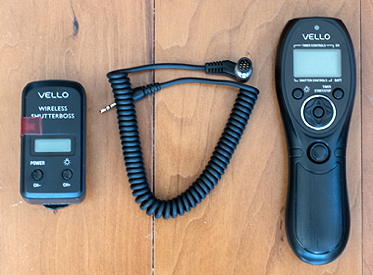Review - Pixel Wireless Shutter Release
Posted: 8 December 2020
![]()
Wireless Shutter Release
Pixel
$46
I have been using a Wireless ShutterBoss Timer Remote with my Nikon D7000 DSLR and Nikon D7200 DSLR since 2012 and then a Vello ShutterBoss Wireless III with a Nikon D850 DSLR beginning in 2018. I really like the capabilities of using a wireless intervalometer for astrophotography. The older ShutterBoss failed in mid-2020 so I began using the model III with both the D7200 and D850. The ShutterBoss III always worked fine with the D7200, but for some reason had problems with the D850. The receiver unit would intermittently trigger random exposures, even when the transmitter was off. Sometimes it would never happen, sometimes it would trigger the shutter infrequently during a session in the observatory (or elsewhere), and sometimes it would happen so frequently that it was a serious nuisance. Vello was never able to determine a cause even after sending me two replacement units that also experienced the same random triggering problem with the D850. Surprising, the original ShutterBoss never did this with the D850 DSLR, but once it failed I had to use the ShutterBoss III.
I decided to try a different wireless shutter release with the D850 DSLR and after some research I ordered the Pixel Wireless Shutter Release. The Pixel comes with a small manual (in five languages), but no batteries (4 AAA required). I purchased the model with cables for the D7200 and D850. There are kits for many cameras.
The Pixel looks very similar to the Vello models.
Vello Wireless ShutterBoss Timer Remote


Vello Wireless ShutterBoss III Timer Remote


Pixel Wireless Shutter Release
![]()
![]()
The Pixel might be from the same supplier, just rebranded. Since it looks so similar I was worried that it might have the same problem as the Vello model with the D850.
Just like the ShutterBoss III, there is a blinking green light on the receiver. I found that light on the ShutterBoss III a little too bright in my observatory so I covered it with red lens tape (seen in the SB III photo above). I also did that with the Pixel after the first use in the observatory. The transmitter has a red light that is not too bright. Both the receiver and transmitter have a dim backlight that can be turned ON (turns OFF automatically after a few seconds).
The manual is confusing in the initial steps to begin using the Pixel. Step 1 (English section) says to power ON the receiver and the camera before connecting the cable to the camera. Then in Step 4 it says to power ON the receiver and the camera after the cable has been connected. The Vello ShutterBoss models could be connected with power ON or OFF, but I always connected them with power OFF on both receiver and camera as that seemed safer (the sequence had no bearing on the random triggering). I decided to not power ON the Pixel receiver or camera until after connecting the cable and had no issues. Unlike the ShutterBoss models, the Pixel has a useful power ON/OFF button on the transmitter. It will automatically turn OFF after 30 minutes if not used. The receiver also has a power ON/OFF button, but does not turn off automatically. The short camera cable can also be connected to the transmitter for wired camera control.
Using the Pixel you can take single photographs or multiple photographs (up to 999), timed, with or without programmable delays between exposures. For astrophotography you can set exposure lengths of 00h00m01s to 99h59m59s. The long exposure mode is what I expect to use the most, as was the case with the ShutterBoss.
The Pixel can start and stop video recording with the D7200 DSLR. That's a nice capability, especially for recording passes of the International Space Station or doing videos of planets for stacking. Unfortunately, the D850 DSLR does not allow remote control for video recording.
I used the Pixel with both my D850 DSLR and the D7200 DSLR and it worked as expected with both cameras for astrophotography.
Summary
The Pixel receiver and transmitter, like the ShutterBoss, are made of plastic and are lightweight and easy to hold. The buttons are easy to use to navigate the various modes and change settings. Based on my experience so far, the Pixel Wireless Shutter Release is an excellent programmable intervalometer and remote shutter release for astrophotography.
Did I experience the random triggering with the D850 DSLR like I did with ShutterBoss III? Not during several sessions of use. Hopefully, the random triggering is now just a memory.
Comments are welcome using Email. If you are on Twitter you can use the button below to tweet this review to your followers. Thanks.
Cassiopeia Observatory Home Page
Copyright ©2020 Michael L. Weasner / mweasner@me.com
URL = http://www.weasner.com/co/Reviews/2020/Pixel_Wireless_Shutter/index.html

